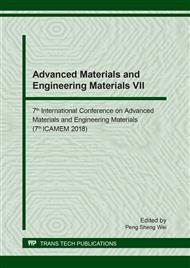[1]
Efficiency, D.o.A.E.D.a. Percentage of alternate energy consumption. (2016).
Google Scholar
[2]
Shravanth Vasisht, M., J. Srinivasan, et al., Performance of solar photovoltaic installations: Effect of seasonal variations. Solar Energy, 2016. 131: pp.39-46.
DOI: 10.1016/j.solener.2016.02.013
Google Scholar
[3]
Sharma, V. and S.S. Chandel, Performance analysis of a 190 kWp grid interactive solar photovoltaic power plant in India. Energy, 2013. 55: pp.476-485.
DOI: 10.1016/j.energy.2013.03.075
Google Scholar
[4]
Krauter, S., Increased electrical yield via water flow over the front of photovoltaic panels. Solar Energy Materials and Solar Cells, 2004. 82(1–2): pp.131-137.
DOI: 10.1016/j.solmat.2004.01.011
Google Scholar
[5]
Huang, M.J., P.C. Eames, et al., Thermal regulation of building-integrated photovoltaics using phase change materials. International Journal of Heat and Mass Transfer, 2004 2715-2733.
DOI: 10.1016/j.ijheatmasstransfer.2003.11.015
Google Scholar
[6]
Maiti, S., S. Banerjee, et al., Self regulation of photovoltaic module temperature in V-trough using a metal–wax composite phase change matrix. Solar Energy, 2011. 85(9): pp.1805-1816.
DOI: 10.1016/j.solener.2011.04.021
Google Scholar
[7]
Elarga, H., F. Goia, et al., Thermal and electrical performance of an integrated PV-PCM system in double skin façades: A numerical study. Solar Energy, 2016. pp.112-124.
DOI: 10.1016/j.solener.2016.06.074
Google Scholar
[8]
Hasan Mahamudul, M.M.R., et al.,, Temperature regulation of photovoltaic module using phase change material: A numerical analysis and experimental investigation. International journal of Photoenergy, 2016. p.8.
DOI: 10.1155/2016/5917028
Google Scholar
[9]
Klugmann-Radziemska, E. and P. Wcisło-Kucharek, Photovoltaic module temperature stabilization with the use of phase change materials. Solar Energy, 2017. 150(Supplement C): pp.538-545.
DOI: 10.1016/j.solener.2017.05.016
Google Scholar
[10]
Gaur, A., C. Ménézo, et al., Numerical studies on thermal and electrical performance of a fully wetted absorber PVT collector with PCM as a storage medium. Renewable Energy, 2017. 109(Supplement C): pp.168-187.
DOI: 10.1016/j.renene.2017.01.062
Google Scholar
[11]
Attakorn Thongtha, C.H.-Y.a.P.L., Influence of Phase Material Application on Photovoltaic Panel Performance. Key Engineering Materials, 2017. 730: pp.563-568.
DOI: 10.4028/www.scientific.net/kem.730.563
Google Scholar
[12]
Beckman, J.A.D.a.W.A., solar engineering of thermal processes, ed. f. edition. 2013: Wiley.
Google Scholar


